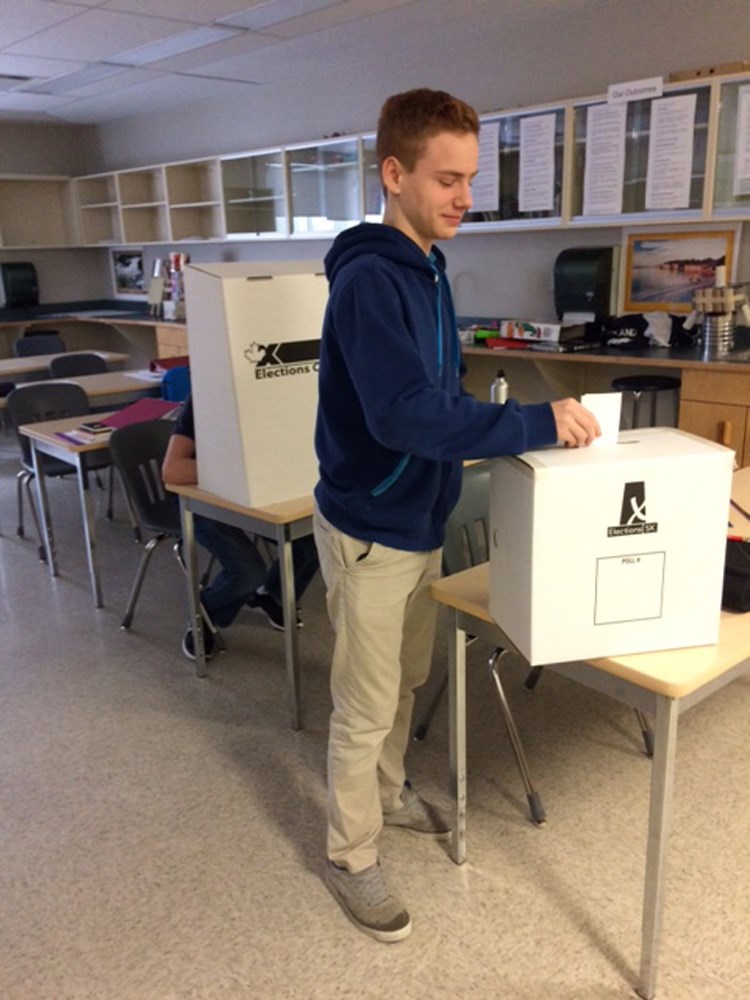With the voting age in Canada being 18-years-old, politicians are not worried about what students are thinking when it comes to election issues.
But thanks to Student Vote, Saskatchewan students are making their voices heard for the 2016 election.
Student Vote provides student focused election curriculum materials and the tools for a school’s very own voting booth in local schools across Canada during election times.
The school based election booths even had some of the same positions as an official elections booth; including Deputy Returning Officer who oversees the election and counts the ballots, poll clerks who had out the ballots, and Scrutineers who observe the election on behalf of a candidate.
Many local schools took part on the province wide election that was “held” Mar. 23-24, including many schools from Horizon School Division.
Nancy Kirzinger who teaches grade 3-4 at Viscount School says it is always interesting to see how the student votes compare to the provincial results of the election. Viscount School also did student vote for the federal election back in October and the classroom results mirrored that of the entire country, says Kirzinger.
With learning about the parties, leaders, and the political spectrum, Kirzinger’s students came to the conclusion that if a person does not know about the candidates, guessing on the ballot is not an option.
“They quite strongly believe that if you don’t know about the issues or you don’t know what you are doing, you shouldn’t vote. They don’t think you should just guess, you should be informed.”
Kirzinger was very interested to watch her student’s higher level thinking, especially when it came to the history of the vote.
Learning how long it took before women, aboriginals, and those of Asian ancestry got to vote was very shocking to them, says Kirzinger.
“They’ve been taught that Canada is one of the most wonderful places to live with rights for all, so to find that out in our history surprised them.”
Angela Fielding’s grade 9 class at Wadena Composite High School were really interested in learning about how elections and governments work and they had a lot of good discussions about politics. Grades 7-9 students voted in their student vote election and Fielding says it was interesting to hear their perceptions.
Issues like health care was a big topic of discussion, especially the NDP’s promise to increase frontline staff.
“We talked about the facts of when we look at these promises we can’t just make decisions based on I like everything they’re promising because we have to look at what’s the whole picture.”
Arlene Pederson’s students at Colonsay School also did both the federal student vote in October and the provincial student vote last week.
For her students, the provincial election dealt with issues that more directly affected them, like health care, school division funding, and the disrepair of Saskatchewan roads.
“When Premier Wall talked about driving in his Ram truck back to Swift Current, talking about the road plans, many of (my students) can say, ‘this road is terrible’...it’s more relevant to them.”
Looking at the differences between federal and provincial elections was the main focus for Jackie Bay’s class at the Humboldt Public
School, including differences between MLAs and MPs, and Premiers and Prime Ministers.
Rather than just talking about voting, actually creating a platform for the students to vote makes it more realistic for the students.
“It gives them a chance to role play and that’s always helpful for some.”
It will not be long before her students are voting for real, says Bay. She hopes the process gets them to an important level of understanding.
Horizon School Division Director, Kevin Garinger, says that this was a great initiative to bring to the division because adults do not often ask kids what their opinions are on important issues.
“They have a very amazing perspective...children, just like our other stakeholders, have answers. We can get to such a greater place when we all are contributing to what that future needs to look like and what our current reality is.”




